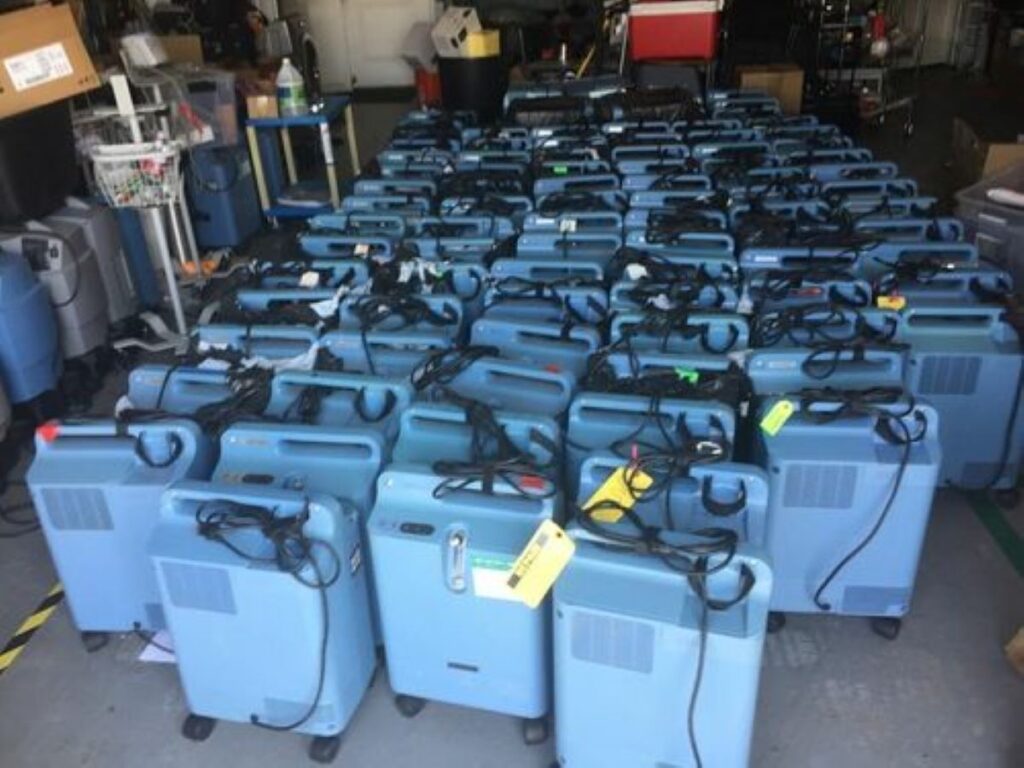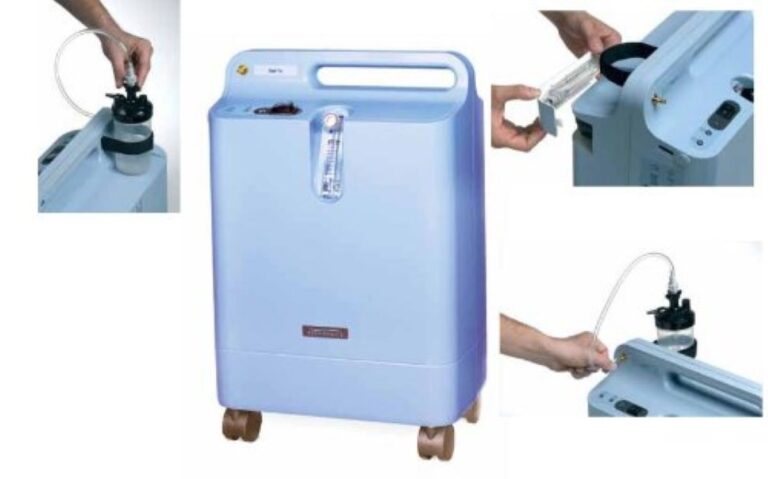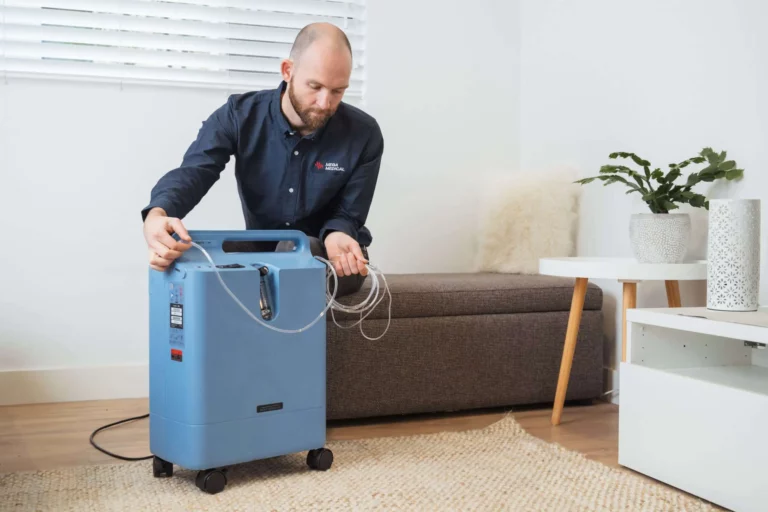What Is the Philips EverFlo Oxygen Concentrator and Why Is It a Popular Choice for Home Therapy?
The Philips EverFlo has become a trusted staple in home oxygen therapy, serving thousands of patients who require supplemental oxygen for long-term respiratory conditions. This stationary concentrator delivers medical-grade oxygen at concentrations of approximately 93% with flow rates ranging from 0.5 to 5 litres per minute.
Its popularity stems from a combination of practical features designed specifically for home environments:
- Lightweight construction at just 14 kg, making it easy to move between rooms
- Whisper-quiet operation at approximately 45 dB—quieter than normal conversation
- Zero patient filter changes required, eliminating routine maintenance hassles
- Energy-efficient design consuming around 350 watts on average
- Durable build quality with metal cannula connectors and recessed flow metres
The EverFlo’s compact footprint, integrated wheels, and moulded handle transform it from a medical device into a manageable household companion. When comparing the EverFlo Concentrator vs other models, these features consistently position it as a popular choice for home therapy amongst both patients and healthcare providers.
How Does the EverFlo Stand Out in Terms of Noise Level Compared to Other Models?
The EverFlo operates at approximately 45 decibels (dB), making it one of the quietest oxygen concentrators available for home therapy. This noise level is similar to that of a quiet library or a soft conversation, allowing users to sleep peacefully and carry out normal household activities without the constant hum of machinery in the background.
Why Quiet Operation Matters
Quiet operation is crucial for oxygen therapy patients who require round-the-clock support. Noisy equipment can disrupt sleep patterns, increase stress levels, and create an uncomfortable living environment for both patients and their families. The EverFlo’s whisper-quiet performance directly addresses these issues.
EverFlo vs Other Models: Noise Level Comparison
A comparison of noise levels between the EverFlo and other models on the market shows significant differences:
| Model Type | Noise Level |
| EverFlo | ~45 dB (library quiet) |
| Standard stationary concentrators | 50-60 dB (normal conversation to dishwasher level) |
| Older or budget models | 60+ dB (comparable to background music or air conditioning units) |
The 5-10 dB difference between the EverFlo and competing models represents a noticeable reduction in perceived loudness. Since the decibel scale is logarithmic, even small numerical differences translate to significant real-world improvements in acoustic comfort.
Benefits of Using Quiet Oxygen Concentrators
Patients using quiet oxygen concentrators report better sleep quality and reduced anxiety about disturbing household members. The EverFlo’s sound-dampening design incorporates advanced engineering that minimises vibration and operational noise without compromising oxygen delivery performance or reliability.
How Does the EverFlo Excel in Energy Efficiency Compared to Competing Devices?
Energy efficiency directly impacts your electricity bills when running an oxygen concentrator 24/7, potentially adding hundreds of pounds to annual costs. The EverFlo’s design prioritises lower power consumption whilst maintaining therapeutic oxygen output, making it a financially sensible choice for long-term home therapy.
EverFlo power usage averages approximately 350 watts during continuous operation—comparable to running a standard desktop computer. This positions it amongst the most efficient stationary concentrators available, with some competing models consuming 400-600 watts under similar conditions. The energy consumption comparison becomes striking when calculated over months of use: a 100-watt difference translates to roughly 72 additional kilowatt-hours monthly, potentially costing an extra £20-30 per month depending on your electricity tariff.
The environmental benefits extend beyond personal savings. Lower power consumption means reduced carbon footprint, particularly relevant for devices operating continuously throughout the year. In fact, the HVAC environmental impact is significantly lessened with such energy-efficient devices. The EverFlo also generates less heat during operation, reducing the need for additional cooling in warmer months and creating a more comfortable home environment.
Key efficiency features include:
- Optimised compressor technology that delivers oxygen without excessive power draw
- Heat management systems that prevent energy waste
- Standby mode capabilities for brief interruptions in therapy
This efficiency doesn’t compromise performance—the EverFlo maintains consistent oxygen concentration whilst using substantially less electricity than older-generation concentrators.
What Maintenance Advantages Does the EverFlo Offer Over Other Models?
The EverFlo eliminates patient-performed filter changes entirely, setting it apart from most competing oxygen concentrators. This design choice removes a recurring maintenance task that typically requires users to purchase replacement filters every few weeks or months, depending on environmental conditions.
Traditional oxygen concentrators demand regular attention to their filtration systems. Users must remember to check, clean, or replace filters to maintain optimal performance and prevent equipment failure. The maintenance advantages of the EverFlo include a sealed system that handles filtration internally, requiring only periodic servicing by qualified technicians during scheduled maintenance visits.
This approach delivers two significant benefits:
- Reduced ongoing costs: No need to purchase replacement filters throughout the device’s lifespan, which can accumulate to hundreds of pounds over several years
- Simplified user experience: Patients and caregivers avoid the confusion of determining when filters need attention or the risk of forgetting this critical task
The concentrator’s durable construction extends these advantages. Metal cannula connectors and recessed flow meters resist accidental damage during routine handling, reducing repair frequency. The device’s compact design with fewer exposed components means less dust accumulation in critical areas.
When comparing EverFlo Concentrator vs Other Models, particularly for elderly users or those with limited dexterity who find routine maintenance tasks challenging, the maintenance factor becomes particularly relevant. Furthermore, the design guide for oxygen concentrators emphasizes usability and low resource settings, further supporting the advantages of the EverFlo model.
How Portable Is the EverFlo Within a Home Setting Compared to Other Stationary Devices?
Can you easily move your oxygen concentrator between rooms? The EverFlo’s 14 kg weight makes it one of the lightest stationary concentrators available, allowing users to relocate it throughout their home without assistance. Built-in wheels and a moulded handle transform what could be a cumbersome medical device into a manageable piece of equipment.
EverFlo portability features address the reality that home oxygen therapy users don’t remain in one room all day. The device rolls smoothly from bedroom to living room, enabling patients to maintain their normal routines whilst receiving continuous oxygen therapy. The compact footprint means it fits comfortably in doorways and tight spaces where bulkier models struggle.
Traditional stationary concentrators often weigh between 18-25 kg, requiring two people to move safely. This weight difference becomes significant for elderly users or those with limited mobility. The EverFlo’s design prioritises home oxygen device mobility without compromising durability—the metal cannula connectors and recessed flow meters withstand frequent repositioning.
The wheels lock securely once positioned, preventing unwanted movement during use. Users report the ability to:
- Move the device between floors using stairs (with appropriate caution)
- Position it discreetly behind furniture or in corners
- Transport it to different rooms for social activities
- Relocate it for cleaning or home maintenance
This level of manoeuvrability supports independence, allowing patients to control their therapy environment rather than being confined to a single location. Click here to get about aomparison of portable Oxygen concentrators and inspired Oxygen levels in a model of respiratory failure.
What Are Common Considerations When Choosing Between the EverFlo and Other Oxygen Concentrators?
Choosing an oxygen concentrator requires evaluating several critical factors that directly impact daily comfort and long-term satisfaction. Your prescription requirements form the foundation—specifically the oxygen flow rate and concentration levels your healthcare provider has specified.
1. Noise Tolerance
Noise tolerance plays a significant role in device selection. If you’re sensitive to sound or plan to use the concentrator in your bedroom, the EverFlo’s 45 dB operation provides a clear advantage over models that generate 50-60 dB, which can disrupt sleep patterns and daily activities.
2. Maintenance Commitment
Maintenance commitment varies dramatically between models. The EverFlo eliminates patient filter changes, whilst many competing devices require weekly or monthly filter cleaning and periodic replacements. Consider how much time and effort you’re willing to dedicate to upkeep tasks.

3. Energy Costs
Energy costs accumulate over years of continuous use. With the EverFlo consuming approximately 350 watts, you’ll spend less on electricity compared to concentrators drawing 400-600 watts. Calculate potential annual savings based on your local electricity rates.
If you’re considering using a hyperbaric oxygen chamber alongside your oxygen concentrator, it’s important to factor in the additional energy costs associated with operating such a device.
4. Portability Requirements
Portability requirements depend on your lifestyle. If you primarily need oxygen therapy within your home, the EverFlo’s 14 kg weight and built-in wheels offer sufficient mobility between rooms. Those requiring outdoor activities or travel should explore portable concentrators as supplementary devices, though these typically deliver lower flow rates.
5. Budget Constraints
Budget constraints encompass both initial purchase price and ongoing operational costs. Factor in electricity consumption, maintenance supplies, and potential repair expenses when comparing models. Some concentrators offer lower upfront costs but higher long-term expenses through increased energy use or frequent part replacements.
If you plan to use your oxygen concentrator away from home, you might need to consider what size generator you require for optimal functionality. This guide on generator sizing could provide valuable insights into making an informed decision.
Conclusion
Should you choose the EverFlo or explore other options for your home oxygen therapy? The answer depends entirely on your unique medical needs and daily routine. The EverFlo Concentrator stands out as a best home oxygen concentrator 2024 contender due to its quiet operation, low maintenance requirements, and energy efficiency—making it ideal for users prioritising comfort and cost-effectiveness.
Your healthcare provider remains your most valuable resource when evaluating the EverFlo Concentrator vs Other Models: Which Is Best for Home Therapy? They can assess your prescribed oxygen flow rates, mobility requirements, and lifestyle factors that influence which device suits you best. Some patients may need higher flow capabilities or portable options for outdoor activities, whilst others benefit from the EverFlo’s home-focused design.
Request a consultation with your oxygen therapy specialist to discuss your prescription requirements, budget constraints, and long-term therapy goals. They can arrange demonstrations or trials of different models, ensuring you invest in equipment that genuinely enhances your quality of life rather than simply meeting basic medical requirements.
More to Read : How to Maintain a Philips Oxygen Concentrator for Long-Term Use


